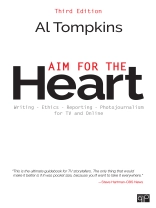Al Tompkins teaches students about broadcast journalism using a disarmingly simple truth—if you aim for the heart with the copy you write and the sound and video you capture, you will compel your viewers to keep watching. With humor, honesty, and directness, award-winning journalist and author Al Tompkins bottles his years of experience and insight in a new Third Edition that offers students the fundamentals they need to master journalism in today’s constantly evolving media environment, with practical know-how they can immediately put to use in their careers. Aim for the Heart is as close as you can get to spending a week in one of Tompkins’s training sessions that he has delivered in newsrooms around the world, from which students:
• Learn how to build compelling characters who connect with the audience
• Write inviting leads
• Get memorable soundbites
• See how to light, crop, frame, and edit compelling videos
• Learn how to leverage social media to engage audiences
• Gain critical thinking skills that move your story from telling the ‘what’ to telling the ‘why’
Содержание
PREFACE
ABOUT THE AUTHOR
INTRODUCTION
CHAPTER 1. AIM FOR THE HEART
Can Great Storytelling Make You Sexier?
All That Is Great, But I’m on a Deadline
Finding Focus: Aim for the Heart of the Story
Use Sound Bites That Connect to The Viewer’s Heart
CHAPTER 2. THE SHAPE OF THE STORY
Stories Need Surprises: Give Viewers Gold Coin Moments
Story Frames: Structure and Restructure
The Big Close: Resolve the Story
Sentences Have Shapes, Too: Power at the End
CHAPTER 3. FIND MEMORABLE CHARACTERS
Put a Face on the Story: You Remember What You Feel
Little Pictures, Big Stories: Focus on People, Not Events
How Many Characters Do You Need in a Story?
CHAPTER 4. WRITE INVITING LEADS
First Impressions: Get Them Hooked
Some Do’s and Don’ts for Leads: Don’t Stall; Get On With It
Kill the Clichés: Especially the Clichés of Thought
CHAPTER 5. VERBS AND ADJECTIVES
The Thing About “ing”: A Passive, Verbless Style
“To Be” or Not “To Be”: Verbs Drive Sentences
Avoid “Fantastic, Unbelievable, Gut-Wrenching” Subjective Adjectives
CHAPTER 6. THE ART OF THE INTERVIEW
Learning to Listen: Using Your Ears More Than Your Mouth
Asking Better Questions
Interviewing Reluctant Sources: Explain the Rationale
Interviewing Juveniles and Other Vulnerable People
A Few Interviewing Don’ts
CHAPTER 7. WHY PICTURES ARE SO POWERFUL
A Little Bit of Visual Theory
The Power of the Picture
The Fannie Lou Hamer Story
CHAPTER 8. THE VITAL ROLE OF LIGHTING
Lighting Sets an Editorial Tone
Construct the Light and Go for the Shadow Side
In Bright Sunlight Add Light
Be Careful
CHAPTER 9. VIDEO AND VISUAL TECHNIQUES
Let’s Get Visual: Capturing Compelling Video
Principles and Techniques for Photographic Objectivity
Special Effects Are “Special”: Use With Care
CHAPTER 10. CAUTION, THIS MAY GET GRAPHIC: THINKING VISUALLY
Think “Shapes”: A Checklist for Effective Graphics
Get It Right: Graphics Are Precision Work
CHAPTER 11. THE SOUND OF THE STORY
Capturing Powerful Sound
Ethical Concerns With Adding Music and Sound Effects
Do Not Rearrange Audio or Sound Bites
CHAPTER 12. WHAT EVERY JOURNALIST SHOULD KNOW ABOUT GUNS, AMMUNITION AND ARMED VIOLENCE
What Is a Caliber/Gauge and Why Does It Matter?
Guns in Crime
Buying and Selling Guns
CHAPTER 13. FIELD TRICKS FROM THE PROS
First Things First in the Field
Story Ideas
Assessing Threats and Staying Safe
CHAPTER 14. TELL THE STORY WITH SOCIAL MEDIA AND ONLINE
Why Online and Social Media Are Important to Local TV
Reporting and Writing for Online
Ethics and Social Networks
Online Skills You Need to Get Hired or to Keep Your Job
CHAPTER 15. ETHICS AND BROADCAST JOURNALISTS: SEEK TRUTH AND REPORT IT AS FULLY AS POSSIBLE
Seek Truth and Report It as Fully as Possible
Who Said That: Evaluating Sources for Your Stories
Be Honest With Viewers About Your Reporting and Your Mistakes
Attack Dogs, Watchdogs and Guide Dogs: A Journalist’s Commitment to Seeking Truth
File Tape: Truthful Reporting or Lazy Journalism?
CHAPTER 16. ETHICS AND BROADCAST JOURNALISTS: ACT INDEPENDENTLY
Avoid Conflicts of Interest
CHAPTER 17. ETHICS AND BROADCAST JOURNALISTS: MINIMIZE HARM
Rights to Privacy for Private People and Public Officials
Covering Criminals and Criminal Acts
Identifying Suspects, Covering “Off-Limits” Stories and Other Tough Ethics Calls
Questions Before You “Go Live”
CHAPTER 18. LET’S GET CRITICAL
Kill the Zombie Stats
Critical Thinking and Polling
Using Critical Thinking to Investigate Charities
Al Gets Duped: Be Skeptical
CHAPTER 19. THE POWER OF ENTERPRISE REPORTING
Enterprise From the Start: Morning Meetings
How to Generate Enterprise Stories
Look for the Story Behind the Story
CHAPTER 20. SURVIVING AND THRIVING IN TODAY’S TV NEWSROOM
How to Succeed
Surviving Layoffs, Cutbacks and Reassignment
Stressed and Overworked
Time Management
Avoid Office Gossip and Politics
Leaders in the Newsroom
The Meaning of Life
INDEX
Об авторе
Al Tompkins is one of America′s best-known and most-requested journalism trainers. Tompkins has taught professional journalists at conferences, conventions, seminars and newsrooms in 46 states and five countries.
Tompkins is the Broadcast and Online Group Leader for The Poynter Institute and has been awarded most of broadcast journalism′s top honors, including The National Emmy, The Peabody, two Robert F. Kennedy Awards, and The American Bar Association’s Silver Gavel for legal reporting.












